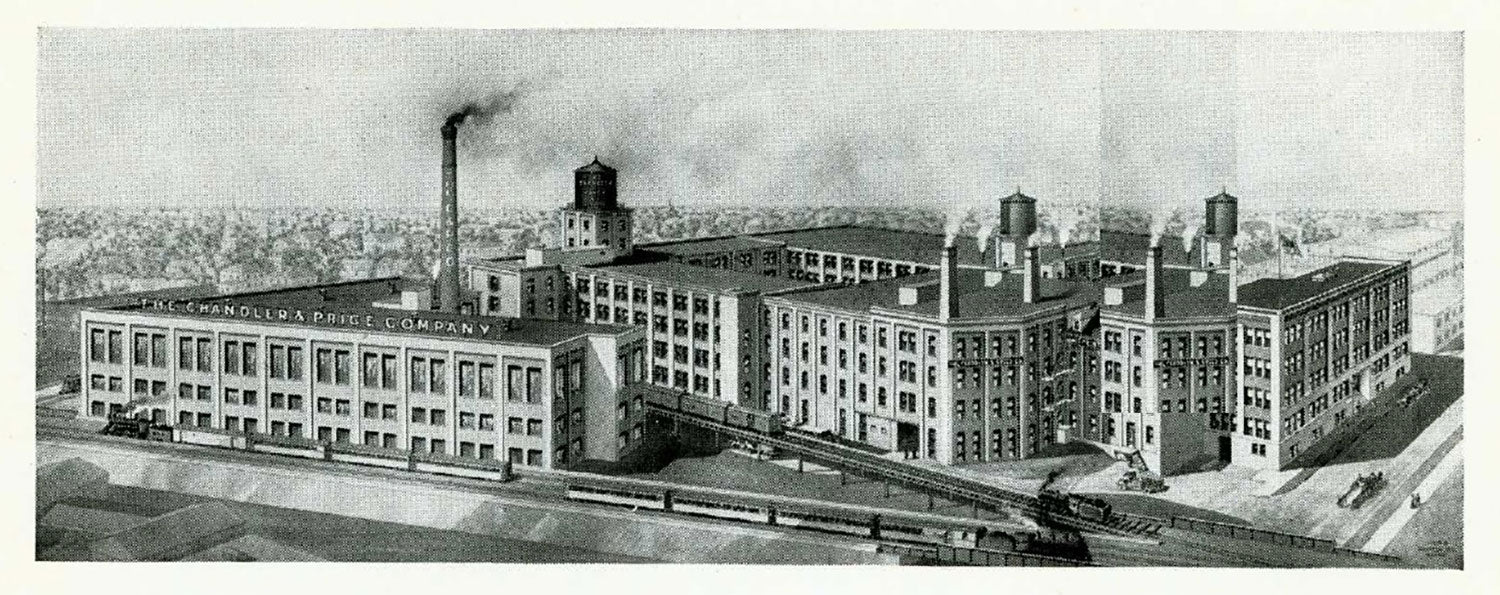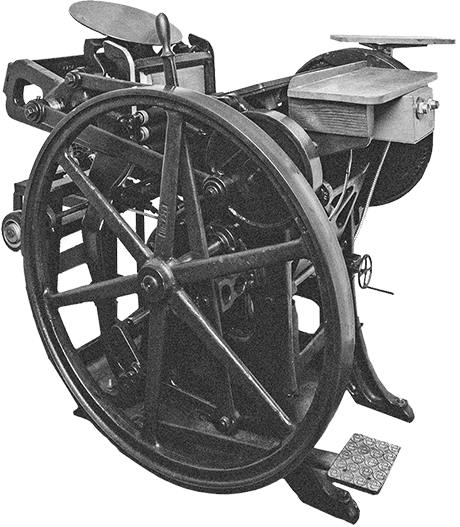Chandler & Price and the Ghost of Benjamin Franklin
by CLAIRE GREEN -
Here at Hoban Cards we love our Chandler & Price letterpresses. We have three of these hardworking beauties, and do the vast majority of our printing on them. We’ve posted glamour shots of our presses here, but for this post, we thought it would be fun to delve into the history of these iconic American machines.
In the world of contemporary letterpress printing, Chandler & Price is a household name. These printing presses are beloved for their reliable, low maintenance, and pragmatic temperaments. As jobbing presses, they are built for shorter runs of small items like stationery and business cards, as opposed to large items like show posters and broadsides, or high volume jobs like newspapers and books. Originally powered by a treadle and fed by hand, the press operator would run the press with his or her foot and feed each sheet of paper one at a time by hand. Printing in this way can be a full body workout with both arms and one leg working with the press! (We eventually got tired of treadling our presses and have fitted small motors to them.) A true workhorse, the C&P can setup quickly, print efficiently, and clean up easily - what more could a job printer ask for?
Before we talk about Chandler and Price, we must first mention George Phineas Gordon. A failed actor turned printer and inventor, Gordon started tinkering with press designs after he opened his own print shop in the 1830’s. He released several press designs in under a decade: The Alligator, The Yankee, The Turnover, and The Firefly, improving the functionality with each new release. A Spiritualist, Gordon claimed to have been visited by Benjamin Franklin in a dream, and was given the basic plans for his next press. This press was hugely successful, and though he named it The Franklin, it became known simply as The Gordon, and the name stuck.
The Gordon press was easy to use and well made, with many improvements to previous “clam-shell” style presses. Older styles of clam-shells quickly snapped open and closed, making them difficult and dangerous to feed. The Gordon press lagged when opening, giving the press operator more time to pull out the printed sheet and feed in the new. His new design, with the platen opening on cams, also improved the overall appearance of the print - making the pressure more consistent from top to bottom. Gordon began manufacturing presses himself in Rhode Island, and through his prolific career built over 100 different kinds of presses. By the end of the 1860’s, the Gordon Press was at its peak popularity, and in the following decades legions of other companies tried to imitate it. By and large, these other presses were cheaply made and didn’t stand the test of time.
 Illustration of Chandler & Price factory. The
factory covers about 4 acres of floor space and is the largest factory in the world making jobbing presses and paper
cutters. Source: Samuel Stephens
Selling Agents Catalog
Illustration of Chandler & Price factory. The
factory covers about 4 acres of floor space and is the largest factory in the world making jobbing presses and paper
cutters. Source: Samuel Stephens
Selling Agents Catalog
The factory covers about 4 acres of floor space and is the largest factory in the world making jobbing presses and paper cutters. Source: Samuel Stephens Selling Agents Catalog Enter Chandler & Price. The year is 1881 and the city is Cleveland, Ohio. Harrison T. Chandler, a banker, meets William H. Price, the son of a press builder. They founded the Chandler & Price Company that year and immediately got to work designing America’s favorite printing press. Thanks to his knowledge of the press building industry, as well as several expired patents from the recently deceased Gordon (he passed away a rich and successful man in 1878), Price released their first jobbing press in 1884. In that first year, 300 presses rolled out the factory doors and production grew quickly after that.
What made C&P’s so successful was their superior quality and ease of use. A catalog advertising the New Series press, sings its praises by claiming that beautiful printing can be achieved by “any practical printer who works with quality in mind” and that “neither unusual experience nor exceptional effort” is necessary. Chandler & Price also manufactured other printing machinery such as paper cutters and book presses (our hard working paper cutter is also a Chandler & Price creation), but it is their jobbing press that is their claim to fame. Many other companies made Gordon-inspired jobbing presses (such as the Challenge Gordon, the Thorpe-Gordon, and the Peerless Gordon to name a few) but by 1910, Chandler & Price had completely taken over the market. In 1911, they released their New Series model in a variety of sizes. Incidentally, we use a 1945 New Series (also called a New Style) for all our calling cards.
 Train for transporting C&P’s
Train for transporting C&P’s
Train for transporting letterpressesTrain for transporting C&P’s In the 1920s and 30s, Chandler & Price focused on automatic paper feeders, in an effort to keep a competitive edge in the market (which worked, as over 90% of jobbing platen presses used during the 1930s were C&P’s!). As offset printing grew in popularity, C&P sales began to decline. Ultimately, offset dethroned letterpress as the primary commercial printing method, and in 1964, Chandler & Price closed its doors after 83 years of production. It is estimated that Chandler & Price produced 100,000 presses, of which a remarkable number are still in use by letterpress enthusiasts and small print shops like us.
 Interior shot of Chandler & Price factory in Cleveland, Ohio
Interior shot of Chandler & Price factory in Cleveland, Ohio
We are proud to keep these beautiful machines purring and we appreciate having a direct connection to one of the great names in American print history. Though our presses have acquired a few battle scars over the years, they still run smoothly. In fact, our Chandler & Price jobbing presses reliably print thousands of calling cards, business cards, notecards, envelopes, and letterhead 52 weeks a year. Three cheers for Chandler & Price!

Thanks for Reading!
We not only love writing about letterpress, typography, and design – we're printers ourselves! We've chosen to carry on the tradition of letterpress printing by offering beautifully pre-designed cards at affordable prices.